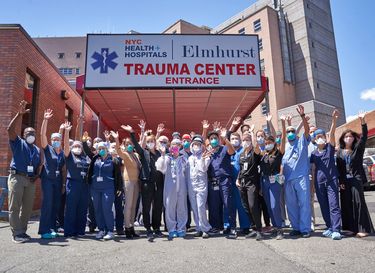1. Power on the machine 2. Press the Start & End key to enter the patient data screen 3. Enter exam data: Patient Last: YOUR IBEX initials Patient ID: Patient’s MR# Press Done 4. Select the desired transducer: Cardiac/Abdo: Cardiac, general torso scanning (including FAST, gallbladder, aorta, etc.) Abdo: general torso scanning Small parts: venous access, procedure guidance, DVT, soft tissue ICT: Intracavitary […]
1. Power On the Machine 2. Scan – High-frequency linear probe is optimized for vessels, nerves, and other superficial structures 3. Clean the Probe! 4. Power off the Machine, Plug it in.
Hello! Welcome to Elmhurst! We have linked some frequently used links below. For Off-Service/Out-of-Hospital Residents EHC ED Orientation Critical Reminders Rotator’s Guide Common Resources: EHCED.org – helpful for ED updates, guidelines and forms. Commonly used numbers in the ED EHC Updates and FAQ CONSENT FORMS – all languages (needs to be open on Elmhurst network) […]
Shoutout to this rare but satisfying procedure! Here is a great review of the causes and procedure and a great review from EM:RAP!
Before placementof your Sengstaken-Blakemore tube, your patient should be intubated to prevent aspiration. As this is only a temporizing measure, other services (GI, ICU, Maybe IR) should be notified and start mobilizing for definitive management. Equipement Sengstaken-Blakemore Tube 60 cc syringe Salem Sump Kelly Clamp 2 Three-way stopcocks with caps Lubricant Manometer Water Sharpie Suction […]
Agents that Can Precipitate Serotonin Syndrome Cocaine MDMA Tramadol Cyclobenzaprine Dextromethorphan St. John’s Wort MAOI Fentanyl Treatment for serotonin syndrome involves supportive care, discontinuing the offending agent, and providing the antidote. Sedation with benzodiazepines is important for controlling agitation as well as correcting mild increases in blood pressure and heart rate. Haloperidol and Droperidol should […]
All of this discussion hinges on understanding the origins of air FLOW. A pressure differential or gradient is the key requirement. Tachypnea is the expected response to lung inflammation that produces stimulation of irritant, stretch, and J receptors. Respiratory rates of 25 to 35 breaths per minute should not be viewed as ipso facto justification […]

